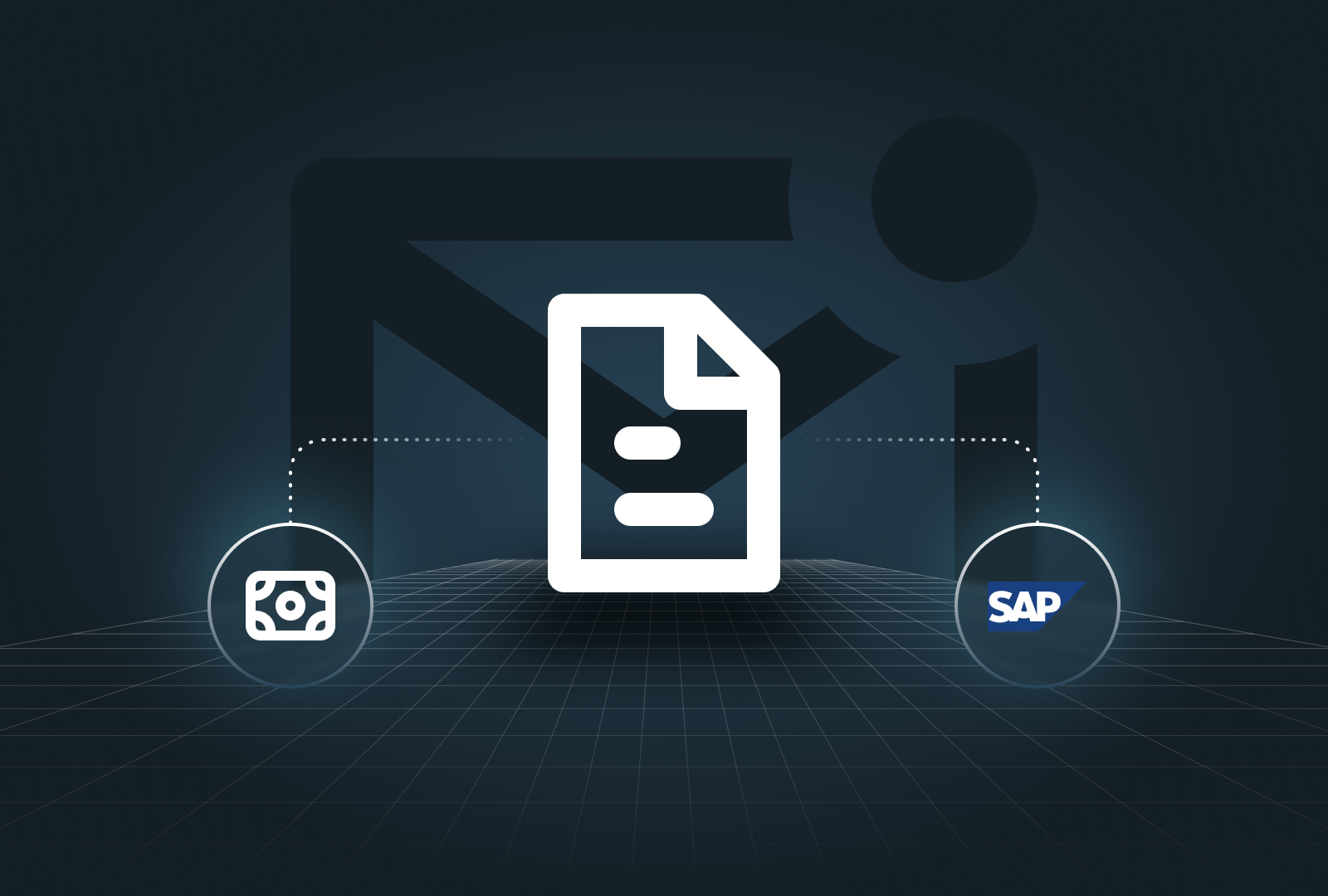In today’s fast-paced business environment, the pressure on finance teams is immense. According to a recent report by Gartner, one-third of accountants admit to making “at least a few financial errors every week” due to capacity constraints¹. These errors, often caused by manual operations and overwhelming workloads, can lead to significant financial risks for businesses.
Implementing an ERP solution like SAP can help mitigate these challenges by automating key tasks in accounts payable (AP), reducing errors, and enhancing overall efficiency. This article explores how SAP ERP streamlines AP processes, the benefits of integrating additional platforms, and best practices for continuous improvement.
Understanding the role of SAP ERP in financial management
SAP ERP plays a vital role in financial management by offering comprehensive tools to manage every aspect of a business’s finances. In particular, SAP ERP streamlines accounts payable processes, automating key tasks and reducing manual errors, making it an essential solution for organizations looking to enhance their financial operations.
What is SAP ERP and how does It support financial operations?
SAP ERP is a comprehensive software solution designed to manage various business functions, including finance, logistics, and human resources. For financial operations, SAP ERP provides tools for managing accounts receivable, accounts payable, general ledger, and financial reporting. It helps businesses keep track of payments, manage vendor relations, and ensure accuracy in financial transactions.
SAP’s capabilities in accounts payable management
SAP’s accounts payable (AP) module automates the entire AP lifecycle—from invoice receipt to payment execution. It integrates with other SAP modules to ensure smooth data flow across departments, minimizing errors and duplications. Features include invoice processing, vendor account management, and approval workflows, all of which help streamline AP operations and ensure timely payments.
SAP vs. specialized solutions for AP
While SAP ERP offers extensive AP management capabilities, specialized AP automation solutions might provide additional functionalities like advanced data analytics or AI-powered invoice recognition. Businesses must assess whether SAP’s built-in AP features meet their needs or if a specialized solution should be integrated for enhanced functionality.
Benefits of integrating a P2P with SAP
While SAP ERP is powerful on its own, integrating it with other platforms unlocks additional functionalities that further enhance the accounts payable process. These integrations improve automation, reduce errors, and ensure that financial procedures are scalable and adaptable to changing business needs. Organizations can significantly benefit from this approach by improving efficiency and reducing costs.
How to enhance SAP ERP capabilities
Although SAP ERP is powerful on its own, integrating external platforms or tools can unlock additional efficiencies. For instance, automating invoice matching or incorporating machine learning (ML) for fraud detection can save time and resources. Enhancing SAP ERP through integrations ensures businesses stay agile and can scale easily.
Reducing manual processes and errors
Automation through SAP ERP and integrations drastically reduces manual entry errors and accelerates operations. By eliminating paper-based tasks and using digital workflows, businesses can minimize human error, shorten invoice approval cycles, and increase payment accuracy.
Better compliance, audit readiness, and real-time insights
With integrated compliance features, SAP ERP helps businesses meet regulatory requirements. It also makes audits more manageable by storing all data in one place, providing audit trails, and enabling real-time financial reporting. These features contribute to better risk management and improved transparency.
Cost-effectiveness and scalability
SAP ERP’s modular design allows businesses to scale as needed, adding functionality or expanding to other business areas without significant restructuring. This cost-effective solution lets businesses start small and expand as their operations grow, ensuring long-term viability without frequent software replacements.
Implementing Payflows for Accounts Payable SAP: Steps and Best Practices
Integrating Payflows with SAP ERP is a strategic way to streamline AP processes. Payflows automates many manual tasks, speeding up invoice approval and payment cycles. 95% of firms that have fully automated their AP processes report achieving greater accuracy, efficiency, and overall streamlining of financial workflows, according to a recent report by PYMNTS².
In this section, we explore the steps to successfully implement Payflows within SAP ERP, including preparation, best practices, and overcoming common challenges during the integration process.
Why Payflows is a powerful combination for streamlined financial processes
Payflows serves as a robust addition to SAP ERP, enhancing its capabilities and simplifying financial management. The platform features pre-built connectors that seamlessly integrate with various ERPs, including SAP S/4HANA and SAP Business ByDesign, ensuring a smooth data flow between systems. This connectivity allows organizations to consolidate their financial procedures and reduce reliance on multiple tools.
Preparing SAP for integration with Payflows
Before integrating Payflows, it's essential to assess your current SAP ERP setup. Ensure that all necessary data is accurately recorded and organized to facilitate a smooth transition. Review your existing workflows to identify areas where Payflows can provide the most significant impact, such as automating invoice processing or improving approval workflows.
Key steps for a successful Payflows implementation
- Establish a project team: assemble a cross-functional team that includes IT, finance, and operations stakeholders to oversee the integration process.
- Define objectives: clearly outline the goals you want to achieve with Payflows, focusing on specific improvements in efficiency, accuracy, and visibility.
- Data mapping: ensure that data fields in Payflows align with your existing SAP ERP configuration for seamless data transfer.
Overcoming challenges during the integration process
Common challenges during integration include data discrepancies and resistance to change among employees. To address these issues, maintain open communication and provide ongoing support throughout the integration process. Leverage Payflows’ user-friendly interface to help employees adapt quickly and reduce the learning curve.
Best practices for continuous improvement
To keep accounts payable operations running efficiently, businesses should focus on continuous improvement through regular updates, process automation, and performance monitoring. This section provides best practices for maintaining a streamlined workflow, ensuring SAP ERP remains effective in managing AP processes over the long term.
Regular updates and customizations for evolving business needs
As businesses evolve, their SAP ERP systems should too. Regular updates ensure that SAP ERP remains aligned with current business goals and external compliance requirements. Customizations also allow companies to tailor workflows and financial activities to their specific needs.
Maximizing automation features to streamline AP workflows
Maximizing automation through SAP ERP’s AP module can significantly reduce operational costs. Automating routine tasks like invoice processing and approvals lets finance teams focus on higher-value activities such as vendor relationship management and strategic planning.
Monitoring KPIs for ongoing optimization
Track key performance indicators (KPIs) like invoice processing time, payment errors, and cost per invoice to continuously improve AP processes. Monitoring these KPIs will help identify areas for further automation and ensure your accounts payable actions remain efficient and scalable.
AI features with SAP for accounts payable
Integrating AI with SAP accounts payable offers a range of advanced features. Payflows AI enhances financial operations through tools like AI Copilot, which answers user questions about procurement and payment statuses, and AI Pre-Filler, which automates data extraction and input using OCR and NLP. Additionally, AI Cost Saver optimizes spending by identifying redundant requests, while AI Risk Detector anticipates non-compliance and liquidity risks.
These AI-driven solutions empower businesses to streamline AP processes, reduce errors, and improve decision-making. This enables companies to maintain a competitive edge while keeping operational costs down.
Integrating SAP ERP with accounts payable processes offers businesses a powerful tool to manage financial operations more efficiently. From reducing manual errors to improving compliance and scalability, SAP ERP provides a robust foundation for AP management. Coupled with platforms like Payflows, companies can further streamline their workflows, accelerate payment cycles, and enhance accuracy.
Sources:
1 - Personiv 2024 Finance & Accounting Talent Market Outlook
2 - PYMNTS - Accounts Payable and Receivable Trends - December 2023





.png)
.png)





.png)



